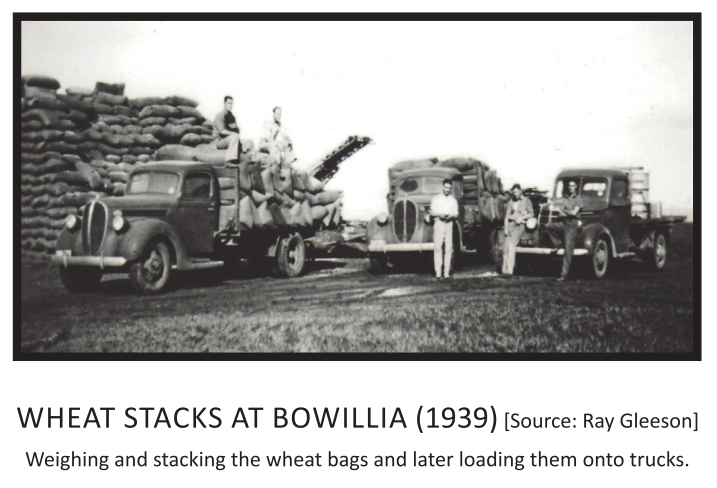

Bowillia School 1888-1951


You may download the above sign graphic as a PDF - click here for PDF version
Below are all the text panels and the larger images featured on the above sign

LIST OF TEACHERS WHO WERE APPOINTED TO BOWILLIA SCHOOL
MISS TURNER 1909
ALOISE HM COWAN 1911
MISS CALABY 1913
MISS ME WHITEHEAD 1923
MAGERY HUGHES 1926
MISS ALICE P MAHONEY 1927 - 1928
MISS McADAM 1929?
WINIFRED O'LOUGHLIN 1931 - 1933
ELIZABETH D GEORGE 1934 - 1935
MAVIS HOSKING 1936
MISS MARGARET I STEPHENS (LATER MRS LEO GLEESON) 1938 - 1939
ELVA LUTZ 1940
RITA EBERHARD 1943
MISS WRIGHT 1st term 1947
MISS KITTO 2nd & 3rd terms 1947
MISS E BRIAN (RESIGNED TO MARRY) 1951
SCHOOL CLOSED 16/04/1951

FAMILIES ATTENDING
BOWILLIA SCHOOL
BISHOP
BRAY
CARLING
CLARKE
GLEESON
GUY
HUTTON
KIRCHNER
LANGE
McENTEE
MUSTARD
NOBLE
O'HARA
PAWELSKI
PEARCE
PEDLER
RUCIAK
SCHUSTER
SHANNON
TILLER
WANDEL
WOODHOUSE
ZACHER


.png)
CONCERT
A largely attended and successful concert was given at Bowillia on Friday night by scholars attending the Bowillia School. A lengthy programme of songs, recitations, etc, was submitted by the children, and the teacher, Miss Calaby, is to be complimented on the manner in which her charges performed. Mr EC Deland presided at the concert. A largely attended supper and dance followed.
[Source: Blyth Agriculturist (SA)
Bowillia is a locality at the junction of five roads, 16 kilometres south-west of Blyth, eight kilometres west of Woodlands and about 32 kilometres north of Balaklava. It was originally known as Everard (not to be confused with Everard East, Central and West). The only community facilities in the very early days were a post office, tennis court and school. There may also have been a Wesleyan Chapel on private land.
The Everard Post Office opened in 1880 with Mr Frances Hack as postmaster, and mail was delivered from Balaklava three times per week. The name changed to Bowillia in 1890. Others in charge of the post office included Ron Kerley, Charles Rattew and Mrs Margaret Gleeson.
The first known school (Hundred of Everard Provisional School) opened in 1881 with 28 students, but closed in 1883, and was followed by another school of the same name which operated from 1895 until 1902. The school location was just a kilometre northwest of the Bowillia crossroads. The first Bowillia School was began in 1888 and functioned until 1893, reopening in 1908.
The Bowillia School was described as a high weatherboard structure about 18 feet by 33 feet with a shelter shed on the northern end. It was comprised of a single room for all students from Grades 1 to 7. The school was also the venue for community events such as farewells and dances. In the days when the roads were just tracks and often blocked by sandhills, the dancers would drive as far as they could and then walk the rest of the way.
Sport played an important social role in the local community and a sports picnic day held in February 1884 is reported to have attracted a crowd of 700 people to watch the horse and flat races.
Many of the school teachers boarded with the family of John (Jack) and Margaret Gleeson who farmed on Sections 85, 86 and 88, Hundred of Everard.
One teacher was Margaret Stephens who eventually married Jack’s brother Leo. As married women were not permitted to continue working, she had of necessity to resign, and so another young single female teacher was appointed to Bowillia School. From 1908 until the school’s closure in 1951 all the teachers were women.
The average attendance at this one-teacher school was about 13, varying from 21 in 1910 to just six in 1943. Like all small country schools, the children travelled to school by various means – they walked, rode bikes or came by horse and cart, with many walking five kilometres each way.
Tennis courts were built next to the school. Two students, Connie Lange and Sylvia Tiller, worked hard to raise money for this project. Combined Schools Picnics were held annually at the Blyth Recreation Ground.
In the 1939/40 season temporary wheat stacks were erected at Bowillia. Tom Gleeson (born 1923) had just turned 16 years of age and got the job of weighing each bag of wheat using platform scales and recording the weight. The scales were moved as the stack grew higher. Each bag was pulled from the wagon using a pulley block attached to a pole and wheat ‘lumpers’ would then carry the bags to build the stack. Trucks were later used by contractors to transport the wheat bags to the rail head.
During the Second World War the students supported the war effort by knitting items such as balaklava caps and socks for the Comfort Fund. They were encouraged to support the SPF or Schools Patriotic Fund by collecting metal for remanufacture. Farming families with members serving in the forces were allotted an Italian Prisoner of War to work as a farm labourer.
Bowillia School closed on 31st March 1951 when the teacher, Miss E Brian, resigned to get married. The remaining seven students transferred to Blyth School.

















